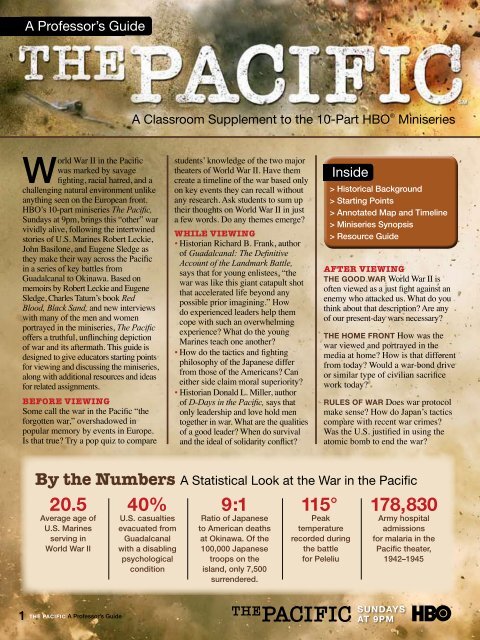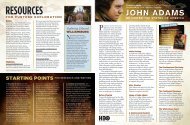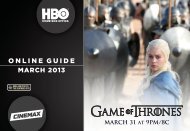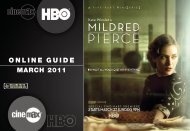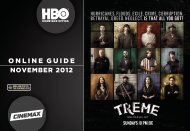Download Guide - HBO.com
Download Guide - HBO.com
Download Guide - HBO.com
Create successful ePaper yourself
Turn your PDF publications into a flip-book with our unique Google optimized e-Paper software.
A Professor’s <strong>Guide</strong><br />
A Classroom Supplement to the 10-Part <strong>HBO</strong> ® Miniseries<br />
World War II in the Pacific<br />
was marked by savage<br />
fighting, racial hatred, and a<br />
challenging natural environment unlike<br />
anything seen on the European front.<br />
<strong>HBO</strong>’s 10-part miniseries The Pacific,<br />
Sundays at 9pm, brings this “other” war<br />
vividly alive, following the intertwined<br />
stories of U.S. Marines Robert Leckie,<br />
John Basilone, and Eugene Sledge as<br />
they make their way across the Pacific<br />
in a series of key battles from<br />
Guadalcanal to Okinawa. Based on<br />
memoirs by Robert Leckie and Eugene<br />
Sledge, Charles Tatum’s book Red<br />
Blood, Black Sand, and new interviews<br />
with many of the men and women<br />
portrayed in the miniseries, The Pacific<br />
offers a truthful, unflinching depiction<br />
of war and its aftermath. This guide is<br />
designed to give educators starting points<br />
for viewing and discussing the miniseries,<br />
along with additional resources and ideas<br />
for related assignments.<br />
Before Viewing<br />
Some call the war in the Pacific “the<br />
forgotten war,” overshadowed in<br />
popular memory by events in Europe.<br />
Is that true Try a pop quiz to <strong>com</strong>pare<br />
students’ knowledge of the two major<br />
theaters of World War II. Have them<br />
create a timeline of the war based only<br />
on key events they can recall without<br />
any research. Ask students to sum up<br />
their thoughts on World War II in just<br />
a few words. Do any themes emerge<br />
While Viewing<br />
• Historian Richard B. Frank, author<br />
of Guadalcanal: The Definitive<br />
Account of the Landmark Battle,<br />
says that for young enlistees, “the<br />
war was like this giant catapult shot<br />
that accelerated life beyond any<br />
possible prior imagining.” How<br />
do experienced leaders help them<br />
cope with such an overwhelming<br />
experience What do the young<br />
Marines teach one another<br />
• How do the tactics and fighting<br />
philosophy of the Japanese differ<br />
from those of the Americans Can<br />
either side claim moral superiority<br />
• Historian Donald L. Miller, author<br />
of D-Days in the Pacific, says that<br />
only leadership and love hold men<br />
together in war. What are the qualities<br />
of a good leader When do survival<br />
and the ideal of solidarity conflict<br />
Inside<br />
> Historical Background<br />
> Starting Points<br />
> Annotated Map and Timeline<br />
> Miniseries Synopsis<br />
> Resource <strong>Guide</strong><br />
after Viewing<br />
The Good War World War II is<br />
often viewed as a just fight against an<br />
enemy who attacked us. What do you<br />
think about that description Are any<br />
of our present-day wars necessary<br />
The Home Front How was the<br />
war viewed and portrayed in the<br />
media at home How is that different<br />
from today Would a war-bond drive<br />
or similar type of civilian sacrifice<br />
work today<br />
Rules of War Does war protocol<br />
make sense How do Japan’s tactics<br />
<strong>com</strong>pare with recent war crimes<br />
Was the U.S. justified in using the<br />
atomic bomb to end the war<br />
By the Numbers A Statistical Look at the War in the Pacific<br />
20.5<br />
Average age of<br />
U.S. Marines<br />
serving in<br />
World War II<br />
40%<br />
U.S. casualties<br />
evacuated from<br />
Guadalcanal<br />
with a disabling<br />
psychological<br />
condition<br />
9:1<br />
Ratio of Japanese<br />
to American deaths<br />
at Okinawa. Of the<br />
100,000 Japanese<br />
troops on the<br />
island, only 7,500<br />
surrendered.<br />
115°<br />
Peak<br />
temperature<br />
recorded during<br />
the battle<br />
for Peleliu<br />
178,830<br />
Army hospital<br />
admissions<br />
for malaria in the<br />
Pacific theater,<br />
1942–1945<br />
1 The Pacific A Professor’s <strong>Guide</strong> Sundays<br />
at 9PM
The Road to Guadalcanal<br />
Historical Background<br />
In the summer of 1941, President<br />
Franklin D. Roosevelt was focused<br />
on the escalating war in Europe. He<br />
believed that America’s entry into the<br />
conflict against Hitler was inevitable.<br />
On the other side of the world, the Japanese<br />
were also aggressively expanding<br />
their empire. Roosevelt hoped to delay<br />
a war with Japan as long as possible,<br />
however, considering Germany the<br />
major threat to American security.<br />
“Japan hoped to establish an<br />
economic empire that extended into<br />
China and Manchuria, down into the<br />
Dutch, French, and British colonies of<br />
Southeast Asia, where there were great<br />
quantities of natural resources such as<br />
rubber, tin and, supremely, oil — the<br />
lifeblood of modern warfare,” says<br />
historian Donald L. Miller. At this time,<br />
Japan purchased 80 percent of its oil<br />
from the United States, and the military<br />
insisted that this reliance on<br />
American oil curtailed Japanese<br />
diplomatic and military<br />
independence, since the U.S.<br />
could turn off the spigot at<br />
any time.<br />
Despite Japan’s increasingly aggressive<br />
posture, Roosevelt hoped diplomacy<br />
and trade sanctions would curb its territorial<br />
expansion. But when the Japanese<br />
army occupied French Indochina (now<br />
Vietnam) in preparation for an invasion<br />
of the oil-rich Dutch East Indies (now<br />
Indonesia) — an area where the U.S.<br />
also traded heavily — Roosevelt placed<br />
an embargo on American oil and iron<br />
exports to Japan.<br />
“Though Japanese militarists<br />
understood that seizing this territory<br />
would almost certainly mean war with<br />
the United States, they were willing<br />
to take that step,” Miller says. The<br />
embargo went into effect in July 1941,<br />
and in the following months Japanese<br />
naval leaders were told to prepare a<br />
plan to attack Pearl Harbor, America’s<br />
naval bastion in the Pacific.The attack<br />
on December 7, 1941 decimated the<br />
American fleet, sinking or damaging<br />
eighteen warships and killing more<br />
than 2,300 servicemen and civilians.<br />
“At the service enlistment posts in the<br />
days after Pearl Harbor, almost all the<br />
volunteers wanted to fight the Japanese;<br />
not the Germans, even though Germany<br />
had declared war on the U.S. on<br />
December 11,” Miller says. “The country<br />
was in a state that can only be described<br />
as panic. With terrifying speed after Pearl<br />
Harbor, the Japanese seized Burma, the<br />
Malay Peninsula, the Dutch East Indies,<br />
Singapore, Hong Kong, the Solomon<br />
Islands, the Philippines, and other island<br />
outposts in the Pacific. Just months after<br />
Pearl Harbor, Japan controlled the largest<br />
oceanic empire in history.”<br />
Japanese territorial aggression<br />
continued until a Marine amphibious<br />
force began landing in August<br />
1942 on a small island in the Solomon<br />
chain called Guadalcanal. The Japanese<br />
were building an airfield on the<br />
island, which would allow their planes<br />
to attack American ships delivering<br />
supplies to Australia, the island nation<br />
from which America intended to begin<br />
its great counter-thrust against Japan<br />
in the Pacific. The impending battle of<br />
Guadalcanal would be the test for the<br />
miserably unprepared American military<br />
as they faced the resolute enemy<br />
that was winning the war in the Pacific.<br />
Starting Points for research and writing<br />
1<br />
After the War Through<br />
studying the accounts of<br />
Sledge and Leckie, the miniseries<br />
goes beyond dates and tactics into<br />
personal metamorphoses. Read one<br />
of their books and write an essay<br />
about how fighting in the Pacific<br />
changed the Marines psychologically.<br />
Did they consider themselves<br />
heroes after the war<br />
Race and the War<br />
2 Before Pearl Harbor, Americans<br />
considered Japan a paper<br />
tiger that couldn’t stand up to our<br />
military, says historian Donald L.<br />
Miller. But after the attack, there<br />
were no defenses between Hawaii<br />
and the West Coast, causing an<br />
invasion scare. Research the racial<br />
attitudes of both sides, as reflected<br />
in the era’s media, advertising,<br />
and propaganda. How does the<br />
caricature of the Japanese change<br />
during the course of the war How<br />
did the Japanese view America and<br />
Americans Prepare a multimedia<br />
presentation on your findings.<br />
“News” vs.<br />
3 “History” Historian<br />
Richard B. Frank says, “There’s<br />
a vast chasm between how World<br />
War II is remembered in this<br />
country and how it was lived. Now<br />
it’s overwhelmingly Hitler, D-Day,<br />
the Holocaust. As it was lived, it<br />
was at least as much Hirohito,<br />
Guadalcanal, and China.” Research<br />
newspaper and newsreel archives<br />
and <strong>com</strong>pare how the two fronts<br />
were covered. Which stories are<br />
still known today, and which ones<br />
have been forgotten Analyze your<br />
findings and present them visually.<br />
4<br />
War and Mental<br />
Illness A large number of<br />
the wounded in the Pacific Theater<br />
were psychological casualties. What<br />
is the incidence of such casualties in<br />
wars today How has the perception<br />
of mental illness during battle<br />
changed Investigate how the U.S.<br />
military handles mental health problems<br />
today and <strong>com</strong>pare current<br />
treatments with those developed<br />
during World War II.<br />
5<br />
The Bushido<br />
Warrior Historian<br />
Richard B. Frank says, “What made<br />
the Pacific war so savage was not<br />
race but the Japanese battle ethics,<br />
that the choice was victory or death.<br />
Japan had not surrendered to a<br />
foreign power in its entire recorded<br />
history of 2,600 years.” Research<br />
Japanese military history and the<br />
evolution of its Bushido — or “no<br />
surrender” — battle ethic. How was<br />
the decision to drop the atomic bomb<br />
our country’s own moral struggle<br />
6<br />
War and Women<br />
“The abrupt acceleration of<br />
life that World War II brought on<br />
affected not only the men but the<br />
women,” says Richard B. Frank.<br />
Write an essay on how the war<br />
helped bring about a more modern<br />
conception of a woman’s role in<br />
society. Examine women in the<br />
military or in the workplace.<br />
2<br />
The Pacific A Professor’s <strong>Guide</strong><br />
Sundays<br />
at 9PM
A Geographic Timeline<br />
Winning the Pacific<br />
August 1942–February 1943<br />
GUADALCANAL<br />
In the first U.S. offensive in the Pacific, 11,000 U.S.<br />
Marines land on this strategically located island to<br />
capture a Japanese airfield. After a land, sea, and air<br />
campaign in which more than 1,700 Americans and<br />
as many as 30,000 Japanese die, the Allied victory<br />
here is a major turning point in the Pacific war.<br />
December 1943–April 1944<br />
CAPE GLOUCESTER<br />
On a tiny island, U.S. and Australian forces face<br />
what historian Donald L. Miller calls “perhaps<br />
the vilest environment in the history of<br />
warfare” to capture a Japanese airfield and<br />
ensure the Allies’ sea passage through the<br />
straits between New Britain and New Guinea.<br />
September–November 1944<br />
PELELIU<br />
A brutally hot coral island with no fresh water supplies,<br />
Peleliu is the site of a bloody and largely forgotten<br />
battle. Nearly 1,800 U.S. Army soldiers and Marines are<br />
killed, and 8,000 are wounded in what Richard B. Frank<br />
calls “a campaign of incredible difficulty and<br />
cruelty” amid “almost <strong>com</strong>plete obscurity.”<br />
February–March 1945<br />
IWO JIMA<br />
On February 19, some 30,000 U.S. Marines<br />
land on Iwo Jima, part of an island chain<br />
just 670 miles south of Tokyo. Facing heavy<br />
resistance, 6,000 U.S. Marines are killed,<br />
nearly a third of the total number who will<br />
die in the entire Pacific war.<br />
April–June 1945<br />
OKINAWA<br />
In this assault, 183,000 Allied troops land on<br />
this island just 350 miles from mainland<br />
Japan. The battle is one of the war’s deadliest,<br />
leaving more than 12,000 American ground<br />
and naval forces, about 60,000 Japanese<br />
soldiers, and countless civilians dead.<br />
3 The Pacific A Professor’s <strong>Guide</strong> Sundays<br />
at 9PM
the miniseries at a glance<br />
Synopsis<br />
Part One After Pearl Harbor, John<br />
Basilone prepares to ship out for the<br />
Pacific, while Robert Leckie enlists in<br />
the Marine Corps. Eugene Sledge, unable<br />
to enlist, says farewell to his friend,<br />
Marines-bound Sidney Phillips. The 1st<br />
Marine Division, including Leckie and<br />
Phillips, lands on Guadalcanal<br />
determined to hold its vital airfield.<br />
Part Two Basilone’s regiment arrives on<br />
Guadalcanal to reinforce Leckie and the<br />
1st Marine Division. Basilone plays a<br />
key role in repelling a nighttime attack,<br />
but suffers a frightful personal loss. After<br />
four months of continuous action, the<br />
exhausted and disease-ridden members<br />
of the 1st Marine Division are evacuated<br />
off the island.<br />
Part Three To recuperate after the fourmonth<br />
ordeal on Guadalcanal, Leckie,<br />
Basilone, and their <strong>com</strong>rades land in<br />
Melbourne. While his buddies carouse,<br />
Leckie be<strong>com</strong>es attached to an Australian<br />
woman and her first-generation Greek<br />
family. Meanwhile, Basilone is awarded<br />
Resources<br />
Books<br />
The Pacific, by Hugh Ambrose<br />
The official <strong>com</strong>panion book to<br />
the <strong>HBO</strong> miniseries fleshes out<br />
the on-screen story, drawing on<br />
research and interviews conducted<br />
in preparation for the miniseries.<br />
With the Old Breed:<br />
At Peleliu and Okinawa,<br />
by E.B. Sledge (Presidio Press,<br />
2007) Sledge’s 1981 memoir is<br />
“not just the classic account of<br />
Pacific <strong>com</strong>bat, but one of the best<br />
accounts of <strong>com</strong>bat ever written,”<br />
says historian Donald L. Miller.<br />
Helmet for My Pillow:<br />
From Parris Island to<br />
the Pacific, by Robert Leckie<br />
©2010 Home Box Office, Inc. All rights reserved. <strong>HBO</strong>® and related<br />
channels and service marks are the property of Home Box Office, Inc.<br />
the Medal of Honor and is sent home to<br />
help sell U.S. war bonds.<br />
Part Four After landing on Cape Gloucester,<br />
Leckie and the others battle both<br />
the Japanese and the debilitating tropical<br />
environment. Surviving Gloucester, and<br />
now stationed on the godforsaken island<br />
of Pavuvu, Leckie begins displaying the<br />
physical and mental effects of <strong>com</strong>bat<br />
and is sent to a naval hospital on nearby<br />
Banika for psychiatric observation.<br />
Part Five Basilone’s celebrity grows<br />
as he continues the war bond tour.<br />
On Pavuvu, Sledge is briefly reunited<br />
with Phillips while Leckie rejoins his<br />
<strong>com</strong>pany. Sledge, Leckie, and the rest<br />
of the 1st Marine Division meet fierce<br />
Japanese resistance while landing on<br />
the intricately and heavily defended<br />
coral island of Peleliu.<br />
Part Six Despite intense heat and a lack<br />
of water, Sledge, Leckie, and other<br />
Marines capture the heavily defended<br />
Peleliu airfield. After seeing two <strong>com</strong>rades<br />
badly injured, Leckie himself<br />
is wounded and evacuated from the<br />
island. Sledge witnesses the shocking<br />
truth about what is sometimes required<br />
to survive and fight another day.<br />
Part Seven On Peleliu, the newly<br />
christened “Sledgehammer” battles<br />
an enemy determined<br />
to fight to the last<br />
man. Devastated by the<br />
(Bantam, 2010) Leckie offers an<br />
unflinching yet poetic account of<br />
his service with the 1st Marine Division<br />
at Guadalcanal, New Britain,<br />
and Peleliu.<br />
Guadalcanal: The<br />
Definitive Account of<br />
the Landmark Battle, by<br />
Richard B. Frank (Penguin, 1992)<br />
Through Japanese accounts and<br />
declassified documents, Frank<br />
reveals the strategies and tactics of<br />
both sides.<br />
D-Days in the Pacific, by<br />
Donald L. Miller (Simon & Schuster,<br />
2005) An illustrated account of the<br />
Allied offensives in the Pacific, from<br />
Guadalcanal to V-J Day.<br />
Films<br />
With the Marines at<br />
Tarawa (1944) This Academy<br />
Award ® -winning film, shot in color<br />
by Marine cinematographers,<br />
shocked audiences with its gruesome<br />
images of the 1943 battle.<br />
The World at War (1974)<br />
Narrated by Laurence Olivier, this<br />
26-episode documentary is considered<br />
the definitive visual history<br />
of World War II. Although its main<br />
focus is Europe, it also contains<br />
sections on the Pacific.<br />
The War (2007), a documentary<br />
by Ken Burns and Lynn Novick,<br />
explores World War II through the<br />
personal accounts of those who<br />
lived through it.<br />
loss of a revered leader, and witnessing<br />
unimaginable barbarity on both<br />
sides, Sledge veers to the edge of moral<br />
collapse. Their objective secured, the<br />
Marines return to Pavuvu fundamentally<br />
changed men.<br />
Part Eight Increasingly frustrated selling<br />
war bonds, Basilone is sent instead<br />
to train troops headed for <strong>com</strong>bat. At<br />
Camp Pendleton, he enjoys a whirlwind<br />
romance with Marine Sergeant<br />
Lena Riggi. The couple knows they are<br />
living on borrowed time, as Basilone<br />
will soon take in the Marine landing<br />
on Iwo Jima.<br />
Part Nine On Okinawa, Sledge and<br />
his men relieve an Army division that<br />
has been in <strong>com</strong>bat against the most<br />
strongly defended Japanese position on<br />
the island. The primordial conditions<br />
and moral dilemma posed by the presence<br />
of civilians strains the physical<br />
and psychological endurance of Sledge<br />
and the others.<br />
Part Ten After the Japanese surrender,<br />
Leckie returns home and Sledge reunites<br />
with his family and Sid Phillips.<br />
Lena has an emotional meeting with<br />
Basilone’s family. Leckie adjusts to<br />
post-war life by resuming his job and<br />
starting a relationship; but for Sledge,<br />
unsure why he survived the war<br />
seemingly unscathed, adjustment will<br />
require more time.<br />
Websites<br />
www.hbo.<strong>com</strong>/<br />
thepacific<br />
The official website for The Pacific<br />
on <strong>HBO</strong> is the ultimate online <strong>com</strong>panion<br />
to the miniseries, featuring<br />
videos, images, downloads and<br />
episode guides.<br />
www.archive.org<br />
The Internet Archive contains a large<br />
collection of World War II newsreels<br />
and military propaganda films.<br />
www.history.army.mil<br />
www.history.usmc.mil<br />
The websites of the U.S. Army Center<br />
of Military History and the U.S.<br />
Marine Corps History Division offer<br />
the official story of military action<br />
in the Pacific.<br />
4 The Pacific A Professor’s <strong>Guide</strong> Sundays<br />
at 9PM


